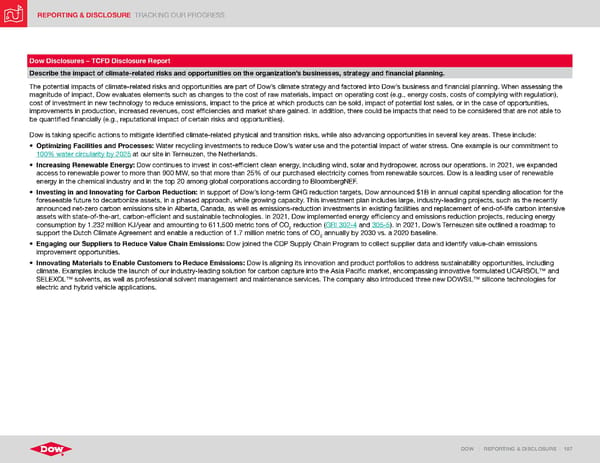REPORTING & DISCLOSURE TRACKING OUR PROGRESS DOW | REPORTING & DISCLOSURE | 187 Dow Disclosures – TCFD Disclosure Report Describe the impact of climate-related risks and opportunities on the organization’s businesses, strategy and financial planning. The potential impacts of climate-related risks and opportunities are part of Dow’s climate strategy and factored into Dow’s business and financial planning. When assessing the magnitude of impact, Dow evaluates elements such as changes to the cost of raw materials, impact on operating cost (e.g., energy costs, costs of complying with regulation), cost of investment in new technology to reduce emissions, impact to the price at which products can be sold, impact of potential lost sales, or in the case of opportunities, improvements in production, increased revenues, cost efficiencies and market share gained. In addition, there could be impacts that need to be considered that are not able to be quantified financially (e.g., reputational impact of certain risks and opportunities). Dow is taking specific actions to mitigate identified climate-related physical and transition risks, while also advancing opportunities in several key areas. These include: • Optimizing Facilities and Processes: Water recycling investments to reduce Dow’s water use and the potential impact of water stress. One example is our commitment to 100% water circularity by 2025 at our site in Terneuzen, the Netherlands. • Increasing Renewable Energy: Dow continues to invest in cost-efficient clean energy, including wind, solar and hydropower, across our operations. In 2021, we expanded access to renewable power to more than 900 MW, so that more than 25% of our purchased electricity comes from renewable sources. Dow is a leading user of renewable energy in the chemical industry and in the top 20 among global corporations according to BloombergNEF. • Investing in and Innovating for Carbon Reduction: In support of Dow’s long-term GHG reduction targets, Dow announced $1B in annual capital spending allocation for the foreseeable future to decarbonize assets, in a phased approach, while growing capacity. This investment plan includes large, industry-leading projects, such as the recently announced net-zero carbon emissions site in Alberta, Canada, as well as emissions-reduction investments in existing facilities and replacement of end-of-life carbon intensive assets with state-of-the-art, carbon-efficient and sustainable technologies. In 2021, Dow implemented energy efficiency and emissions reduction projects, reducing energy consumption by 1.232 million KJ/year and amounting to 611,500 metric tons of CO 2 reduction ( GRI 302-4 and 305-5 ). In 2021, Dow’s Terneuzen site outlined a roadmap to support the Dutch Climate Agreement and enable a reduction of 1.7 million metric tons of CO 2 annually by 2030 vs. a 2020 baseline. • Engaging our Suppliers to Reduce Value Chain Emissions: Dow joined the CDP Supply Chain Program to collect supplier data and identify value-chain emissions improvement opportunities. • Innovating Materials to Enable Customers to Reduce Emissions: Dow is aligning its innovation and product portfolios to address sustainability opportunities, including climate. Examples include the launch of our industry-leading solution for carbon capture into the Asia Pacific market, encompassing innovative formulated UCARSOL™ and SELEXOL™ solvents, as well as professional solvent management and maintenance services. The company also introduced three new DOWSIL™ silicone technologies for electric and hybrid vehicle applications.
 ESG Report | Dow Page 186 Page 188
ESG Report | Dow Page 186 Page 188